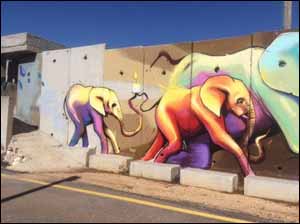 | |
| How a herd of elephants is keeping Israelis safe from Hezbollah snipers | |
The last thing one would expect to see playfully plodding along the border between Israel and Lebanon would be a herd of colourful elephants.
However, running along the border where it passes the northern Israeli farming community of Shtula that is what one sees — a quite unbelievable apparition in the first instance, but after gentle rubbing of the eyes, no illusion, the critters are definitely walking the line! The elephants, as well as a whole host of other large and small animals, long black-haired young ladies in floral dresses seemingly floating in space, as well as regional flora and fauna, are all painted on a wall constructed by Israel to protect against enemy snipers on the other side of the divide. The majority of the border in this area is marked off by an electronic security fence alongside a road, but where the Israeli homes, fields and orchards lead up to the border those more vulnerable areas are protected by a wall, on the other side of the original protective fence. Through observation points here and there in the colourful artistic menagerie and more on the Shtula section of wall — built from enormous blocks of concrete — one can clearly see large and small villages dotting the undulating southern Lebanese hills in the near distance. Neatly marked off Lebanese fields of tobacco, corn and other crops, tractors ploughing recently harvested areas, small private vehicles moving along a road all clearly viewed. Some of the vehicles are passing by small and large flat and slanted red-roofed white houses. Actually, it does not really look that much different from the Israeli side, making it even more difficult to realise one is standing at a point between two countries who have been in conflict with each other for decades. However, the idyllic rural scene viewed through the purpose-built observation platforms in the wall is also interspersed with large yellow flags of Hezbollah. The flapping material atop very high poles quickly reminds one of why the wall was constructed in the first place. It was in this area earlier this year that six Hezbollah attack tunnels were discovered and destroyed by the IDF. One of those tunnels was about to break surface was bang in the middle of Israeli fields and orchards situated between Shtula and their neighbouring Israeli agricultural community of Zarit. The artistic panels on the Shtula wall, created by both Israeli and other artists from a number of different countries, is the work of an organisation known as Artists 4 Israel whose main objective is to prevent the spread of anti-Israel bigotry through art and helps communities and people affected by terrorism and hate. In order to physically approach and truly appreciate the artwork on the wall, one needs to pass through a large, heavy bright yellow gate in the security fence. The road runs between the gate/fence and wall. Logic dictates that the fence was built first, then the wall as the fence was not a sufficient enough deterrent to the Lebanese snipers ensconced in the grassy hillsides in the near distance.
If you have a story or an issue you want us to cover, let us know - in complete confidence - by contacting newsdesk@jewishtelegraph.com, 0161-741 2631 or via Facebook / Twitter

|
 TAKEN TO TUSK: Colourful elephants on the wall in Shtula
TAKEN TO TUSK: Colourful elephants on the wall in Shtula